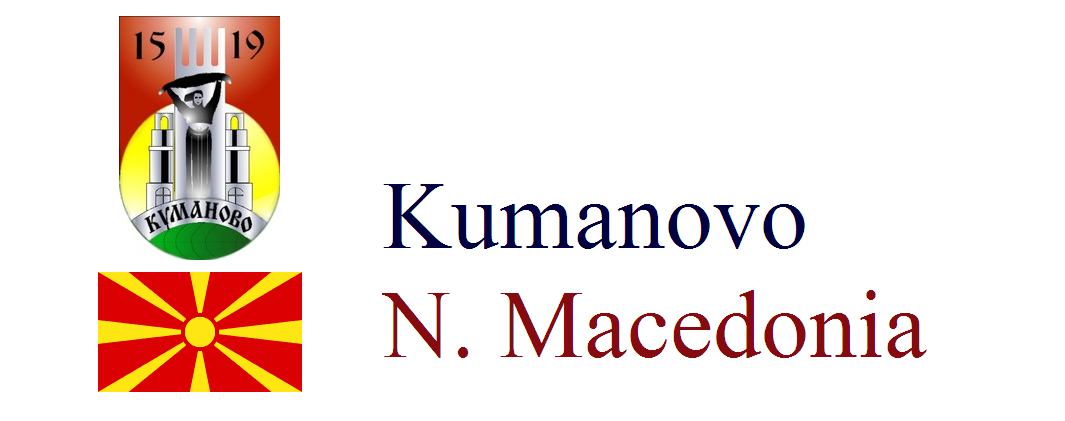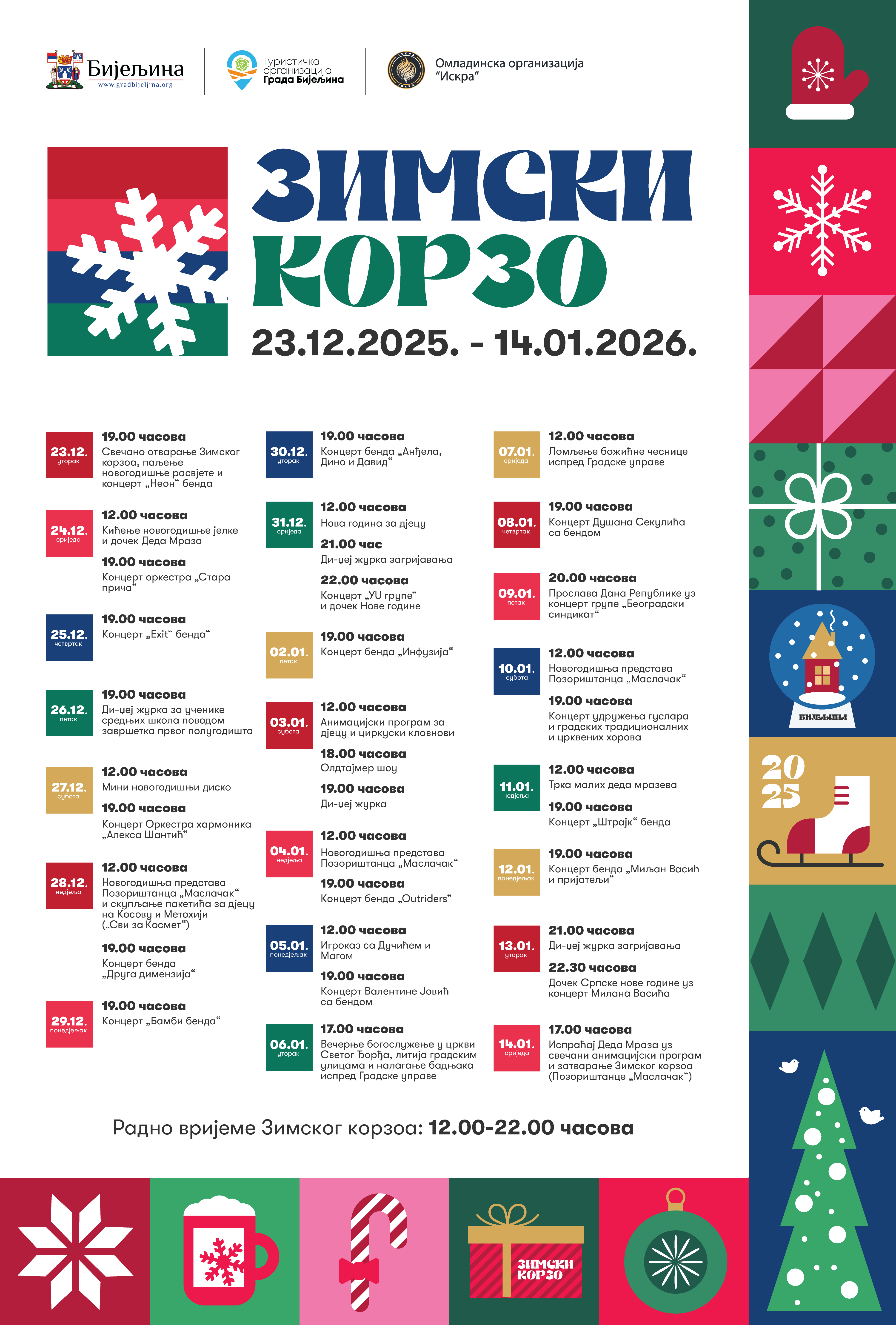Kumanovo (North Macedonia)

Kumanovo is a city in the north-east of North Macedonia and, with over 70 thousand inhabitants, the third largest city (after Skoplje and Bitola), and the seat of the largest municipality in the country.
Twinning agreement between Kumanovo and Bijeljina was signed in 2006.
HISTORY
It is believed that the name of the city derives from the name of Cumans tribe that conquered this area in the late 11th century, and kept it under its authority for a while.
It is believed that Kumanovo was established as a settlement in the 12th century. The first mention was in a Turkish document in 1519 as a village in Nagoric nahiye, with 52 families and around 300 inhabitants. In the late 16th and early 17th century, Kumanovo became a town and the centre of the nahiye. The town developed during this period and became an important trading crossroad.
Turkish travel writer Evliya Çelebi mentioned that in 1660 Kumanovo had 600 houses covered with shingles, a mosque, madrasah, caravanserai, a number of shops and mills. After Austrian army broke into Balkans during the Battle of Vienna, there was a rebellion in the Kumanovo area, where the rebels, with the help of Austrian army, fought the Turks. The leader of the rebels Karposh proclaimed himself “King of Kumanovo” which tells us that Kumanovo was famous.
Turkish-Austrian warfare in the late 17th and early 18th century caused trade stagnation, and Kumanovo lost its importance, so it is mentioned only twice in the documents from the 18th century. The 19th century introduced a new progress and Kumanovo became an important crops market. The railroad built during the 70s of the 19th century gave a new stimulus for the development of Kumanovo which became dominant in comparison to neighbouring towns, including Skoplje. With economic progress, the influx of population also grew.
During the First Balkan War, in October 1912, at the location of Zebrnjak near the town, there was a famous Battle of Kumanovo in which the Serbian army, under the command of General Radomir Putnik, defeated the Turks. This victory marked the beginning of Turkish defeat in the war and opened a path for the final liberation of the Balkans from the Turkish slavery. The monument to the fallen Serbian soldiers, built at the location of the battle, was mostly destroyed by Bulgarian occupiers in the Second World War.
During the Second World War, Kumanovo, together with Prilep, became known as the town where the national liberation uprising started.
After 1945, Kumanovo saw a fast economic and cultural development.
ECONOMY
The most developed economic activities in Kumanovo belong to the secondary and tertiary sectors. The most important are metal processing, textile, leather, food and tobacco industries, as well as agriculture and trade. Kumanovo is an important crossroad towards Skoplje, Serbia, and Bulgaria.
CULTURE
The most important cultural events in Kumanovo are the international Jazz festival, Days of comedy, several festivals and art colonies for children.
The most important cultural institutions are the theatre, Cultural Centre “Trajko Prokopiev” and the National Museum.
There are important cultural and historical monuments around the city, and the most important are Gradište, a site from the Bronze Age, Neolithic site near the village of Donje Nagoričane, the Church of Saint George in Staro Nagoričane from 1701, and the Church of the Holy Mother of God in the village of Matejče from 1350.
Saint George is the patron saint of the city.
INTERNATIONAL COOPERATION
In addition to Bijeljina, Kumanovo is a sister city / twin town of the following cities/towns: Vranje, Gornji Milanovac, Leskovac, Pančevo, Čukarica, Kosovska Mitrovica (Serbia), Nikšić (Montenegro), Nicosia (Cyprus), Plovdiv (Bulgaria), Varaždin (Croatia), Corlu (Turkey), and Prozor (BaH).
LINKS
http:/www.kumanovo.gov.mk
en.wikipedia.org/wiki/Kumanovo
Twinning agreement between Kumanovo and Bijeljina was signed in 2006.
HISTORY
It is believed that the name of the city derives from the name of Cumans tribe that conquered this area in the late 11th century, and kept it under its authority for a while.
It is believed that Kumanovo was established as a settlement in the 12th century. The first mention was in a Turkish document in 1519 as a village in Nagoric nahiye, with 52 families and around 300 inhabitants. In the late 16th and early 17th century, Kumanovo became a town and the centre of the nahiye. The town developed during this period and became an important trading crossroad.
Turkish travel writer Evliya Çelebi mentioned that in 1660 Kumanovo had 600 houses covered with shingles, a mosque, madrasah, caravanserai, a number of shops and mills. After Austrian army broke into Balkans during the Battle of Vienna, there was a rebellion in the Kumanovo area, where the rebels, with the help of Austrian army, fought the Turks. The leader of the rebels Karposh proclaimed himself “King of Kumanovo” which tells us that Kumanovo was famous.
Turkish-Austrian warfare in the late 17th and early 18th century caused trade stagnation, and Kumanovo lost its importance, so it is mentioned only twice in the documents from the 18th century. The 19th century introduced a new progress and Kumanovo became an important crops market. The railroad built during the 70s of the 19th century gave a new stimulus for the development of Kumanovo which became dominant in comparison to neighbouring towns, including Skoplje. With economic progress, the influx of population also grew.
During the First Balkan War, in October 1912, at the location of Zebrnjak near the town, there was a famous Battle of Kumanovo in which the Serbian army, under the command of General Radomir Putnik, defeated the Turks. This victory marked the beginning of Turkish defeat in the war and opened a path for the final liberation of the Balkans from the Turkish slavery. The monument to the fallen Serbian soldiers, built at the location of the battle, was mostly destroyed by Bulgarian occupiers in the Second World War.
During the Second World War, Kumanovo, together with Prilep, became known as the town where the national liberation uprising started.
After 1945, Kumanovo saw a fast economic and cultural development.
ECONOMY
The most developed economic activities in Kumanovo belong to the secondary and tertiary sectors. The most important are metal processing, textile, leather, food and tobacco industries, as well as agriculture and trade. Kumanovo is an important crossroad towards Skoplje, Serbia, and Bulgaria.
CULTURE
The most important cultural events in Kumanovo are the international Jazz festival, Days of comedy, several festivals and art colonies for children.
The most important cultural institutions are the theatre, Cultural Centre “Trajko Prokopiev” and the National Museum.
There are important cultural and historical monuments around the city, and the most important are Gradište, a site from the Bronze Age, Neolithic site near the village of Donje Nagoričane, the Church of Saint George in Staro Nagoričane from 1701, and the Church of the Holy Mother of God in the village of Matejče from 1350.
Saint George is the patron saint of the city.
INTERNATIONAL COOPERATION
In addition to Bijeljina, Kumanovo is a sister city / twin town of the following cities/towns: Vranje, Gornji Milanovac, Leskovac, Pančevo, Čukarica, Kosovska Mitrovica (Serbia), Nikšić (Montenegro), Nicosia (Cyprus), Plovdiv (Bulgaria), Varaždin (Croatia), Corlu (Turkey), and Prozor (BaH).
LINKS
http:/www.kumanovo.gov.mk
en.wikipedia.org/wiki/Kumanovo

